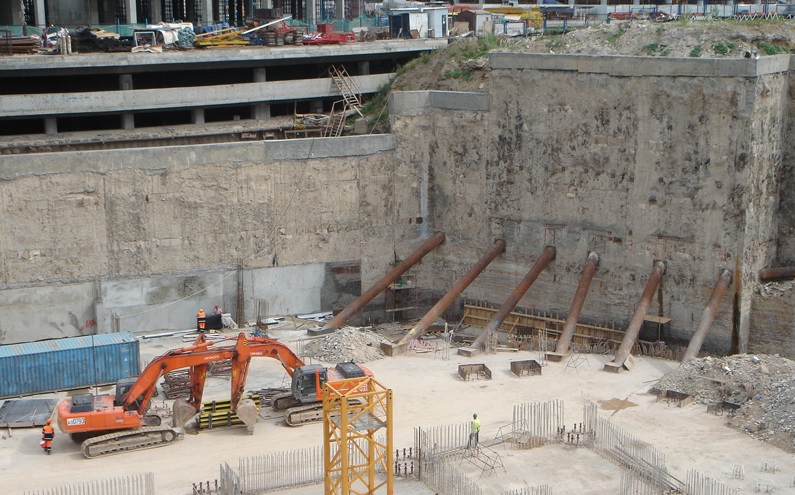Diaphragm wall
A diaphragm wall is a structural concrete wall constructed in a deep trench excavation, either cast in situ or using precast concrete components. Diaphragms walls are often used on congested sites, close to existing structures, where there is restricted headroom, or where the excavation is of a depth that would otherwise require the removal of much greater volumes of soil to provide stable battered slopes.
Diaphragm walls are suitable for most subsoils and their installation generates only a small amount of vibration and noise, which increases their suitability for works carried out close to existing structures. In addition, floor slab connections and recessed formwork can be incorporated into the walls.
The walls generally range in thickness from 500 - 1,500 mm and can be excavated to depths of over 50 m. Excavation is typically carried out using rope-suspended mechanical or hydraulically-operated grabs. Specific ground conditions or greater depths may require the use of hydromills – hydraulically-operated reverse circulation trench cutters – to penetrate into hard rock by ‘cutting’ rather than ‘digging’. Hydromills can achieve depths of up to 80 m.
The excavation stability is maintained by the use of a drilling fluid, usually a bentonite slurry. This is a controlled mixture that has thixotropic properties, meaning that it exerts a pressure in excess of the earth and hydrostatic pressures on the sides of the excavation. The walls are constructed, using reinforced or unreinforced concrete, in discrete panel lengths generally ranging between 2.5 - 7 m. Purpose-made stop ends can be used to form the joints between adjacent panels, with a water bar incorporated across the joints. More complicated arrangements such as ‘L’ or ‘T’-shaped panels can be constructed where additional bending moment capacity or wall stiffness is required.
Precast concrete diaphragm walls have the same advantages but are less flexible in terms of design. The units are installed in a trench filled with a special mixture of bentonite and cement with a retarder added to control the setting time. Ground anchors are used to tie the panels or posts to the retained earth to provide stability.
The high cost of diaphragm walls can make them uneconomic unless they can be incorporated into part of a building structure. As such, they are suited for deep basements, underground car parks and rail stations, tunnel approaches, underpasses, deep shafts for tunnel ventilation, pumping stations, and so on.
[edit] Related articles on Designing Buildings Wiki
- Basement excavation.
- Building foundations.
- Crosswall construction.
- Curtain wall.
- Diaphragm.
- Excavating plant.
- Ground anchor.
- Groundworks.
- Metal profile cladding.
- Partition wall.
- Rainscreen.
- Retaining walls.
- Secant pile wall.
- Sheet piles.
- Substructure.
- Trench.
- Trombe wall.
- Wall ties.
- Wall types.
[edit] External references
- Bacsol - Diaphragm walls
- ‘Building Construction Handbook’ (6th ed.), CHUDLEY, R., GREENO, R., Butterworth-Heinemann (2007)
Featured articles and news
One of the most impressive Victorian architects. Book review.
RTPI leader to become new CIOB Chief Executive Officer
Dr Victoria Hills MRTPI, FICE to take over after Caroline Gumble’s departure.
Social and affordable housing, a long term plan for delivery
The “Delivering a Decade of Renewal for Social and Affordable Housing” strategy sets out future path.
A change to adoptive architecture
Effects of global weather warming on architectural detailing, material choice and human interaction.
The proposed publicly owned and backed subsidiary of Homes England, to facilitate new homes.
How big is the problem and what can we do to mitigate the effects?
Overheating guidance and tools for building designers
A number of cool guides to help with the heat.
The UK's Modern Industrial Strategy: A 10 year plan
Previous consultation criticism, current key elements and general support with some persisting reservations.
Building Safety Regulator reforms
New roles, new staff and a new fast track service pave the way for a single construction regulator.
Architectural Technologist CPDs and Communications
CIAT CPD… and how you can do it!
Cooling centres and cool spaces
Managing extreme heat in cities by directing the public to places for heat stress relief and water sources.
Winter gardens: A brief history and warm variations
Extending the season with glass in different forms and terms.
Restoring Great Yarmouth's Winter Gardens
Transforming one of the least sustainable constructions imaginable.
Construction Skills Mission Board launch sector drive
Newly formed government and industry collaboration set strategy for recruiting an additional 100,000 construction workers a year.
New Architects Code comes into effect in September 2025
ARB Architects Code of Conduct and Practice available with ongoing consultation regarding guidance.
Welsh Skills Body (Medr) launches ambitious plan
The new skills body brings together funding and regulation of tertiary education and research for the devolved nation.
Paul Gandy FCIOB announced as next CIOB President
Former Tilbury Douglas CEO takes helm.
























Comments
Understanding the advantages and disadvantages of ground water control in reference to this method would be interesting.